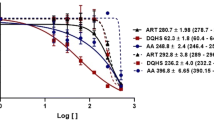Abstract
An unprecedented increase in the incidence of unresponsiveness to antimonial compounds has highlighted the urgent need to develop new antileishmanial agents. The leaves of Piper betle (locally known as Paan) have long been in use in the Indian indigenous system of medicine for its antimicrobial properties but its antileishmanial potential has not been studied. Accordingly, an ethanolic extract of leaves of Piper betle (PB) was tested for its antileishmanial activity that was evidenced in both promastigotes and amastigotes, with IC50 values of 9.8 and 5.45 μg/ml, respectively; importantly, it was accompanied by a safety index of >12-fold. This leishmanicidal activity of PB was mediated via apoptosis as evidenced by morphological changes, loss of mitochondrial membrane potential, in situ labeling of DNA fragments by terminal deoxyribonucleotidyltransferase-mediated deoxyuridine triphosphate nick end labeling, and cell-cycle arrest at the sub-G0/G1 phase. Taken together, the data indicate that PB has promising antileishmanial activity that is mediated via programmed cell death and, accordingly, merits consideration and further investigation as a therapeutic option for the treatment of leishmaniasis.



Similar content being viewed by others
References
Ahua KM, Ioset JR, Ioset KN, Diallo D, Mauel J, Hostettmann K (2007) Antileishmanial activities associated with plants used in the Malian traditional medicine. J Ethnopharmacol 110:99–104
Arnoult D, Akarid K, Grodet A, Petit PX, Estaquier J, Amiesen JC (2002) On the evolution of programmed cell death: apoptosis of the unicellular eukaryote Leishmania major involves cysteine protease activation and mitochondrion permeabilization. Cell Death Differ 9:65–81
Croft SL, Sundar S, Fairlamb AH (2006) Drug resistance in leishmaniasis. Clin Microbiol Rev 19:111–126
CSIR (1969) The wealth of India, vol. 8. Council of Scientific and Industrial Research, New Delhi, pp 84–94
Desjeux P (2004) Leishmaniasis: current situation and new perspectives. Comp Immunol Microbiol Infect Dis 27:305–318
Dube A, Singh S, Sundar S, Singh N (2005) Refractoriness to the treatment of sodium stibogluconate in Indian kala-azar field isolates persist in in vitro and in vivo experimental models. Parasitol Res 96:216–223
Dutta A, Mandal G, Mandal C, Chatterjee M (2007a) In vitro antileishmanial activity of Aloe vera leaf exudate: a potential herbal therapy in leishmaniasis. Glycoconj J 24:81–86
Dutta A, Bandyopadhyay S, Mandal C, Chatterjee M (2007b) Aloe vera leaf exudate induces a caspase independent cell death in Leishmania donovani promastigotes. J Med Microbiol 56:629–636
Evans PH, Bower WS, Funk EJ (1984) Identification of fungicidal and nematocidal components in the leaves of Piper betle (Piperaceae). J Agric Food Chem 32:1254–1256
Ganguly S, Bandyopadhyay S, Sarkar A, Chatterjee M (2006) Development of a semi automated colorimetric assay for screening anti-leishmanial agents. J Microbiol Methods 66:79–86
Ganguly S, Mula S, Chattopadhyay S, Chatterjee M (2007) An ethanol extract of Piper betle Linn. mediates its anti-inflammatory activity via down-regulation of nitric oxide. J Pharm Pharmacol 59:711–718
Mittra B, Saha A, Chowdhury AR, Pal C, Mandal S, Mukhopadhyay S, Bandyopadhyay S, Majumder HK (2000) Luteolin, an abundant dietary component is a potent anti-leishmanial agent that acts by inducing topoisomerase II-mediated kinetoplast DNA cleavage leading to apoptosis. Mol Med 6:527–541
Moreira ME, Del Portillo HA, Milder RV, Balanco JM, Barcinski MA (1996) Heat shock induction of apoptosis in promastigotes of the unicellular organism Leishmania (Leishmania) amazonensis. J Cell Physiol 167:305–313
Nalina T, Rahim JHA (2007) The crude aqueous extract of Piper betle L. and its antibacterial effect towards Streptococcus mutans. Am J Biotech Biochem 3:10–15
Sawangjaroen N, Phongpaichit S, Subhadhirasakul S, Visutthi M, Srisuwan N, Thammapalerd N (2006) The anti-amoebic activity of some medicinal plants used by AIDS patients in southern Thailand. Parasitol Res 98:588–592
Sen N, Das BB, Ganguly A, Mukherjee T, Tripathi G, Bandyopadhyay S, Rakshit S, Sen T, Majumder HK (2004) Camptothecin induced mitochondrial dysfunction leading to programmed cell death in unicellular hemoflagellate Leishmania donovani. Cell Death Differ 11:924–936
Sen R, Bauri A, Chattopadhyay S, Chatterjee M (2007a) Antipromastigote activity of the malabaricones of Myristica malabarica (rampatri). Phytother Res 21:592–595
Sen R, Bandyopadhyay S, Dutta A, Mandal G, Ganguly S, Saha P, Chatterjee M (2007b) Artemisinin triggers induction of cell-cycle arrest and apoptosis in Leishmania donovani promastigotes. J Med Microbiol 56:1213–1218
Singh N, Mishra PK, Kapil A, Arya KR, Maurya R, Dube A (2005) Efficacy of Desmodium gangeticum extract and its fractions against experimental visceral leishmaniasis. J Ethnopharmacol 98:83–88
Sundar S, Chatterjee M (2006) Visceral leishmaniasis - current therapeutic modalities. Indian J Med Res 123:345–352
Sundar S, More DK, Singh MK, Singh VP, Sharma S, Makharia A, Kumar PC, Murray HW (2000) Failure of pentavalent antimony in visceral leishmaniasis in India: report from the center of the Indian epidemic. Clin Infect Dis 31:1104–1107
Tasdemir D, Kaiser M, Brun R, Yardley V, Schmidt TJ, Tosun F, Ruedi P (2006) Antitrypanosomal and antileishmanial activities of flavonoids and their analogues: in vitro, in vivo, structure-activity relationship, and quantitative structure-activity relationship studies. Antimicrob Agents Chemother 50:1352–1364
Trakranrungsie N, Chatchawanchonteera A, Khunkitti W (2007) Ethnoveterinary study for antidermatophytic activity of Piper betle, Alpinia galanga and Allium ascalonicum extracts in vitro. Res Vet Sci 84(1):80–84
Verma NK, Singh G, Dey CS (2007) Miltefosine induces apoptosis in arsenite-resistant Leishmania donovani promastigotes through mitochondrial dysfunction. Exp Parasitol 116:1–13
Acknowledgements
This work received financial assistance from the Life Sciences Research Board, Defense Research Development Organization, the University Grants Commission, Council of Scientific and Industrial Research, Government of India. RS, SG, and GM are recipients of Senior Research fellowships from Lavanya Prova Bose Trust, University Grants Commission and Council of Scientific and Industrial Research, Government of India, respectively.
Author information
Authors and Affiliations
Corresponding author
Rights and permissions
About this article
Cite this article
Sarkar, A., Sen, R., Saha, P. et al. An ethanolic extract of leaves of Piper betle (Paan) Linn mediates its antileishmanial activity via apoptosis. Parasitol Res 102, 1249–1255 (2008). https://doi.org/10.1007/s00436-008-0902-y
Received:
Accepted:
Published:
Issue Date:
DOI: https://doi.org/10.1007/s00436-008-0902-y




